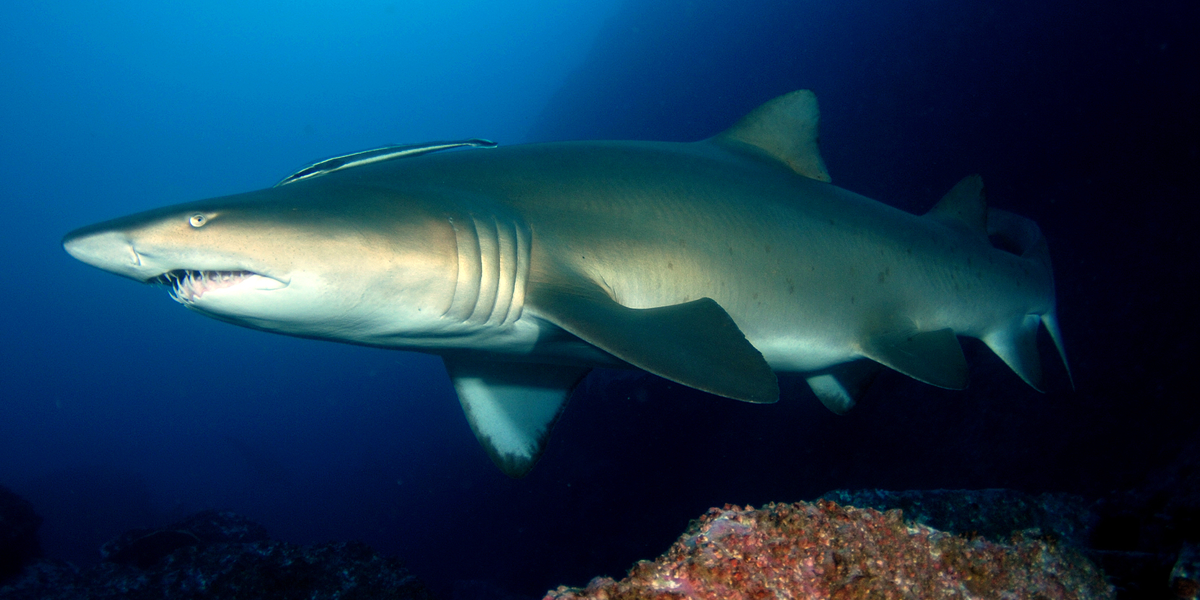November 19, 2018

A new estimate of adult population size for Australia’s eastern Grey Nurse Shark population drew on widespread genetic sampling and forensic exploration of family trees.
This CSIRO-led project, funded by the Marine Biodiversity Hub, built on data collections and analytical techniques developed in a suite of related projects completed under this partnership. It collated existing tissue samples and collected new samples from Grey Nurse Sharks at aggregation sites and from shark control programs in Queensland and New South Wales (in partnership with the University of Queensland and the NSW Department of Primary Industries).
Adult population size and trend for the eastern population was estimated using close-kin mark-recapture (CKMR): an approach that combines advanced genetics and statistical modelling. The approach was applied to two maturity scenarios, due to uncertainties relating to the age of Grey Nurse Sharks at maturity.
Scenario 1 estimated the number of adult sharks for the eastern population at 2167 (range: 1257– 3078), with an adult survival rate of 97 percent a year and a 3.4% (range 1.2–5.7%) annual rate of increase.
Scenario 2 estimated the number of adult sharks for the eastern population at 1686 (range: 956–2417), with an adult survival rate at 95 percent a year and a 4.5% (range 2.5–4.7%) annual rate of increase. A total population estimate could not be produced, due to a lack of available information on juvenile rates of survival.
Based on modelled estimates of a positive annual rate of increase, the eastern Grey Nurse Shark population is believed to have made some overall recovery since protection was implemented. This presumably is as a result of a range of protection measures including the voluntary ban on capture by game-fishers in 1979 followed by NSW Government protection in 1984, and the implementation of critical habitat areas throughout their eastern distribution.
Close-kin mark-recapture
The close-kin mark-recapture technique used for the eastern Grey Nurse Shark population estimate works on the premise that the number of close-kin pairs in a population is related to the size of the population being estimated. For example, a small adult population typically would have a high number of close-kin pairs such as half-siblings, while a large adult population would have a small number of close-kin pairs. The close-kin pairs were identified using mitochondrial DNA collected from 374 sharks.
Strategies to guide future monitoring and research
The project made recommendations to guide future monitoring and research on Grey Nurse Shark populations in Australia. They included improved understanding of age estimates derived from examining growth rings in shark vertebrae, continued tissue sampling of live animals, surveys using baited remote underwater camera systems, and continued photo identification.
Conservation status
Grey Nurse Sharks are found across tropical and temperate regions of the North and South Atlantic, Indian and western Pacific oceans, to depths of at least 230 metres. Internationally, they are listed as Vulnerable on the International Union for Conservation of Nature Red List of Threatened Species.
Australia has distinct eastern and western populations, each inhabiting an approximate 2700-kilometre stretch of coastal waters. The eastern population ranges from central Queensland to at least the New South Wales/Victoria border and the western population ranges from Western Australia’s North West Shelf to at least Cocklebiddy in the Great Australian Bight.
The eastern population is listed as Critically Endangered under the Australian Environment Protection and Biodiversity Conservation Act 1999. Objective 1 of the 2014 national recovery plan for the Grey Nurse Shark is to: Develop and apply quantitative monitoring of the population status (distribution and abundance) and potential recovery of the Grey Nurse Shark in Australian waters.
Previous population estimates for Grey Nurse Shark in 2009 and 2010 relied on photo identification, but this technique can have challenges relating to covering the full geographic range of the population, and the accuracy of matching the sharks’ spot markings.
Resources
- Fact sheet https://www.nespmarine.edu.au/document/sizing-australia%E2%80%99s-easter...
- Report https://www.nespmarine.edu.au/document/close-kin-mark-recapture-estimate...
- Marine Hub on Facebook https://www.facebook.com/marinebiodiversityhub/timeline
- Marine Hub on Twitter https://twitter.com/NESPmarinehub
- CSIRO blog https://blog.csiro.au/nursing-grey-nurse-shark-populations-back-to-health/
- Log in to post comments
